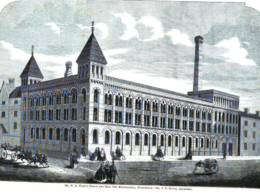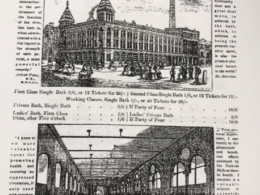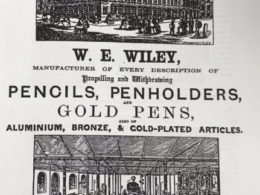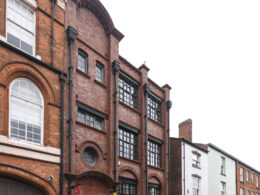By Joan Turner and Siân Scholes, research volunteers
The Argent Centre was built in 1863 for the propelling pencil and gold pen manufacturer W.E. Wiley at a cost of £5,000.[1] Built by Mr Heywood to the designs of architect J. G. Bland it acquired the name Albert Works possibly because it was opposite the Victoria Works of Joseph Gillott. Wiley employed around 250 people here until production ceased in 1876 when his company merged with other pen manufacturers.
Behind the building’s monumental Lombardic Renaissance façade are narrow, multi-storey workshops only about 16 feet wide, surrounding an open courtyard. This allowed natural light to reach workbenches from two sides. The building originally had pyramids on each corner tower and plans are progressing to restore them. The unusual use of hollow bricks, formed into flat arches with wrought ties, to construct the upper floors rendered the building fireproof, whilst the addition of a basement storey enabled ‘successive storeys to be added without the slightest interruption to business’.[2]
However, the most interesting feature of the building was its Turkish baths, which were heated by passing air through connections to the boiler flues and by using waste steam from the engines working the factory machinery. The baths occupied three suites over three floors with the first floor used by working men, the second as a first-class bath and the third by ladies. The décor was described as luxurious, with Indian matting flooring and luxurious couches, whilst billiards, chess and fencing were offered to ‘add to the enjoyment of the bathers’. According to the Birmingham Daily Post there were even staff wearing ‘full Turkish costume’. [3] The baths were open to the public from 7am to 10pm, with single bath prices ranging from 1 shilling to 2 shillings and 6 pence.
After Wiley left the site he offered the empty factory to the 1st Volunteer Battalion the Royal Warwickshire Regiment and the building was renamed the Argent Centre in 1881 when it was occupied by silversmiths W.J. Myatt. Subsequently it has been used by the scientific equipment supplier Griffin & George and laboratory equipment suppliers Gallenkamp. It was converted into offices in 1993 and is now home to the Pen Museum, which focuses on the important legacy of Birmingham’s nineteenth-century pen trade and the significant contribution it made to improving literacy throughout the world.
It is interesting to note that before the Albert Works were built this site was occupied by a house called Camden Hill. It was here that the American writer Washington Irving, whilst staying with his sister and her husband Henry van Wart, wrote the famous story of Rip van Winkle. Irving, who used the pen name Geoffrey Crayon, would write through the night and read to his hosts over breakfast the next day.[4]
[1] The Building News, 21 August 1863
[2] The Building News, 21 August 1863
[3] Birmingham Daily Post, Opening of Mr Wiley’s Turkish Baths, 13 February 1863
[4] http://web.archive.org/web/20151002165621/http://www.birmingham.gov.uk/irving
Building Timeline
1863
The Albert Works open
1876
Wiley’s business amalgamates with other pen manufacturers and he leaves the Albert Works
1881
Renamed the Argent works when occupied by silversmiths W.J. Myatt
1993
Converted into offices
2001
The Pen Museum opens







